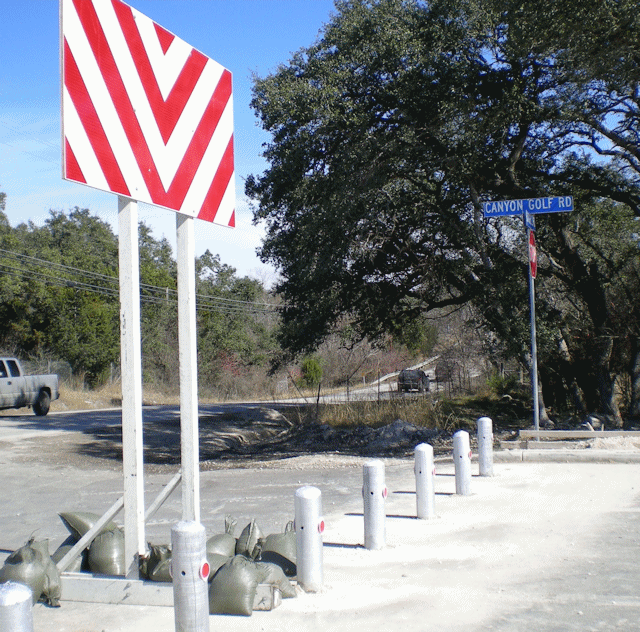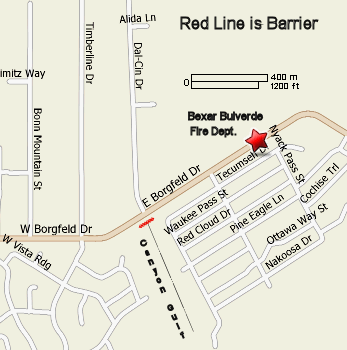Link to story here.
State Error: Bridge Cost Triples
By Brian Collister
WOAI-TV
2/05/08

When the ritzy subdivision, the Dominion, was annexed several years back, the City of San Antonio promised to build a highway overpass on I-10 so emergency vehicles could cross the highway.
But you won’t believe what it is costing you.
Let us explain it to you this way: You know how you take you car to a mechanic and they give you an estimate for what it will cost to fix the problem, but later they call and tell you they found a lot more wrong and the bill has skyrocketed?
Well, it is happening to you again but with your tax dollars. This time, thanks to the folks who are building the Dominion bridge.
News 4 Trouble Shooter Brian Collister uncovered the staggering numbers.
Construction on the Dominion overpass is already half way done.
The new fire station the city promised when it annexed the area is already finished after being moved from its temporary location just 1 mile away.
It sits just a few feet away where fire trucks will soon be able to dart under the highway when the call comes out for an emergency in the Dominion.The station and bridge were the city’s way of smoothing over fear from angry Dominion homeowners who fought the city’s land grab in 1998.
“The times that they are quoting to us, response times for fire and EMS are just not adequate,” said Billie Kite-Howlett back in 1998, a homeowner in the Dominion at the time. “We’re very, very concerned about that.”
To help it win the annexation battle and swallow up the subdivision packed with multi-million dollar homes, the city got a quick estimate from TxDoT right before the city council was set to vote. Engineers said they could do the project for $6.5 million.
But today, that cost has ballooned to $20 million!
Pretty pricey, even for taxpayers around the Dominion who told the News 4 Trouble Shooters on-camera the price seems like an incredible amount of money.
TxDoT admits it did not do much homework at all when it came up with the initial price tag.
During an interview with News 4 Trouble Shooter Brian Collister, TxDoT engineer Clay Smith explained, “It’s not until you get into the detail design that you realize what it’s going to cost you.”
“But isn’t that TxDoT’s job to say here is how much this is going to cost, we looked at it?” asked Collister.
“Correct, and that’s what you do with your estimate. You give them the best engineering estimate you have at the time,” replied Smith.
“But this one was way off,” countered Collister.
“Yeah, well, like I said, you had a lot of factors,” added Smith.
The biggest factor? TxDoT says its engineers did not realize the project is in the 100 year flood plain.
Which is pretty weird, since anyone who was here during the flood of ’98 saw what happened to Rudy’s BBQ, which is just up the road from the bridge site.
When asked why TxDoT did not look at a flood map before it provided its estimate, Smith answered, “It just, ah, we developed the equipment real quick. We didn’t have the money in there to accommodate was actually going to need in there.”
So now the overpass project that was supposed to cost $6 million is costing $20 million.
“It costs what it costs,” said Smith.
But TxDoT would have known what it really cost from the start if they simply had done some digging like we did.
For starters, the city, which asked for the bridge, knew about the flood plain.
Records obtained by News 4 from 1983 show the Dominion wanted a city permit to build another exit to the subdivision in the same area, but it was denied because it is in the 100-year flood plain.
So when did TxDoT figure it out?
An environmental study we uncovered, done in 2001, notes the flood plain, but still says it will only cost $6 million. It wasn’t until later that engineers realized that because of the problem they would have to build a much larger and more expensive bridge that includes concrete side walls.
Bexar County Commissioner Lyle Larson sits on the Metropolitan Planning Organization, which is responsible for handing out the money for roads.
“Anybody (who) saw the ’98 floods when Macaroni Grill and Rudy’s, all of those were washed out. There should have been some intuitive understanding that that area is prone to flooding,” says Larson. “You’re right, I don’t know why they would not have included the flood plain element in their bids, but maybe they were just rushed at that point.”
Larson says the skyrocketing cost has meant other highway projects are being delayed.
And that also means you will pay more when those projects finally get started because of rising costs of construction materials and labor.
“All of the escalation that we’ve seen on this project, you can see the projects in 98, 99, 2000, that we thought we’d start in 2003, 2004. You’re going to see a significant increase on those, as well,” says Larson.
Because of what happened with the TxDoT project and others that have gone over-budget, the MPO now requires the agency to give better estimates and provide updates more frequently during a project to stop it from happening again.
We called the Dominion Homeowners Association to see what it thinks of the cost of the overpass. We got no response.




